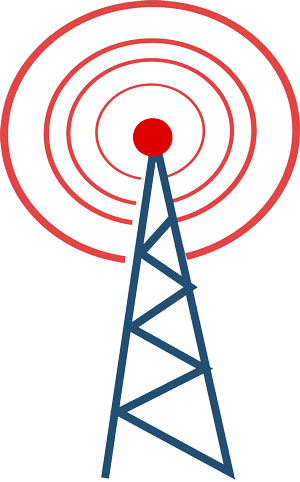By: John Shepler
In today’s interconnected world, businesses depend heavily on infrastructure like electricity, telephone lines, and internet connectivity, often delivered through copper cables. While electricity and landline phones are widely accessible due to national initiatives, internet availability, particularly broadband via copper or fiber optic cables, diminishes as you move away from city centers. Rural areas often lack wired internet infrastructure entirely, leaving businesses with limited choices.
One option for these areas is wireless internet.
Point to Point Microwave
Point-to-point (PTP) microwave acts as a substitute for fiber optic cables, transmitting data using high-frequency waves, sometimes even light beams. This fixed service requires a clear line of sight between small dish antennas installed at both the sending and receiving ends, typically on buildings. These high frequencies struggle to penetrate solid objects but offer substantial bandwidth, reaching a Gigabit per second or more. Although initially common in densely populated urban areas where installing fiber was costly or time-consuming, PTP microwave dishes are now frequently seen on cell towers in rural locations. If a provider covers your area, PTP microwave could be a viable option.
Wireless Internet Service Providers
Wireless Internet Service Providers (WISPs) operate from a central tower that broadcasts wireless internet to a defined area, functioning like powerful outdoor Wi-Fi routers. Similar to PTP microwave, an outdoor antenna, possibly a small dish, is needed on your building, aimed at the tower. WISPs can utilize licensed or unlicensed spectrum and typically offer speeds comparable to standard broadband. They are prevalent in areas where fiber or cable internet is unavailable, but their reach is localized, so availability varies.
Cellular Broadband Service
Smartphones have become ubiquitous, and their primary function now extends far beyond making calls. The broadband internet connectivity they offer powers countless apps and keeps us tethered to our screens. Businesses can leverage this same connectivity for their needs by utilizing access points—devices similar to smartphones in their broadband capabilities but without the display or phone features.
For occasional or limited use, basic access points purchased from retail stores and configured for your chosen carrier might suffice. These function well in areas with strong cellular reception but usually come with restricted data plans. Connect this access point to your router, or purchase one with a built-in Wi-Fi router, to provide internet access for your entire business.
For more demanding applications, specialized business-grade access points are available. These utilize enhanced antennas for improved signal reception, sometimes including external antennas, ensuring a robust signal even in remote locations. Typically operating on 4G LTE or 5G networks, these business-oriented access points offer larger data plans, often with unlimited options, suitable for businesses with multiple employees.
The widespread availability of cellular infrastructure, increasingly reaching rural communities and smaller towns, makes this option particularly appealing. For businesses constantly on the move, such as those operating from shifting job sites or temporary retail locations, cellular broadband might be the sole practical solution for maintaining connectivity.
Satellite Broadband
Even in the most remote areas with limited access to cellular service, landline phones, or even electricity, satellite broadband can provide internet connectivity. This involves using a satellite dish aimed at communication satellites in geostationary orbit. Modern high-power satellites deliver fast speeds, reliable service, and business-friendly data plans at reasonable costs.
The primary drawback of satellite broadband is the inherent latency caused by the extensive distance signals must travel to and from the satellite. This delay, typically half a second to a full second, can disrupt business operations reliant on cloud services, VoIP calls, or video conferencing. However, latency might not pose a significant issue for activities such as email, web browsing, remote data collection, or file transfers.
Emerging constellations of Low Earth Orbit (LEO) satellites offer a potential solution to latency issues. These satellites orbit closer to Earth, resulting in latencies comparable to cable or long-distance fiber optic connections. SpaceX leads the charge with a growing network of broadband satellites poised to provide global coverage, including maritime regions, within the next few years. Other providers are expected to follow suit, recognizing the vast potential market for connecting underserved areas.
If reliable, affordable broadband internet is crucial for your business, explore the range of wired and wireless solutions available in your area today.


